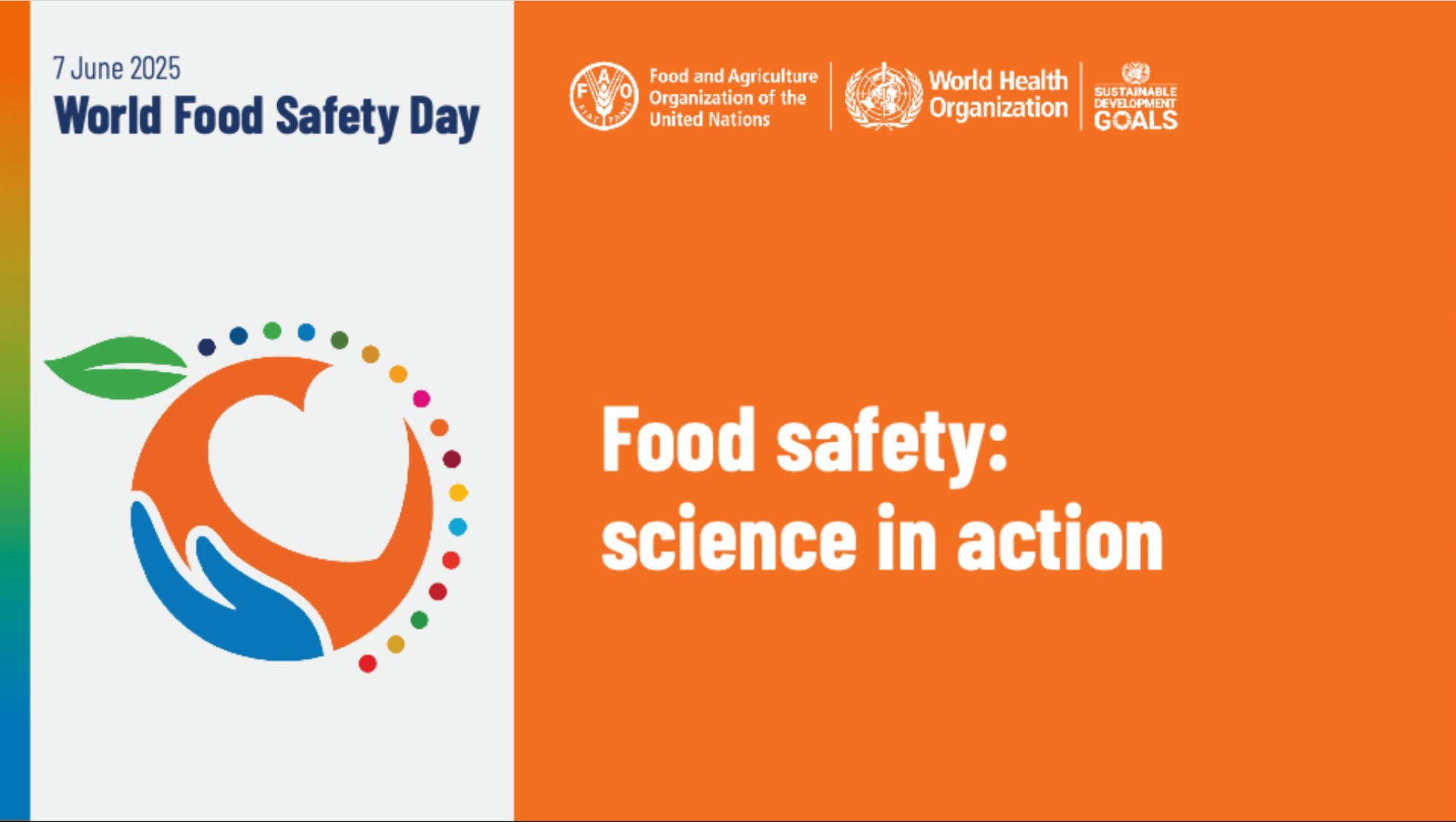World Food Safety Day 2025: Science in Action
Published in Social Sciences, Microbiology, and Agricultural & Food Science

WHO and the Food and Agriculture Organization of the United Nations (FAO) jointly facilitate the observance of World Food Safety Day each year on 7 June, working closely with Member States and other stakeholders including civil society, academia, and others.

Food Safety and Risk: Relaunched and Growing
We’re excited to announce the relaunch of Food Safety and Risk, a fully open-access, peer-reviewed journal dedicated to advancing food safety through science and published under the BMC brand. We invite researchers to contribute work on:
- Risk assessment and management
- Social and economic dimensions of food safety
- Systemic and interdisciplinary approaches
With new publications on the horizon and a fresh collection launching soon, we’re building a vibrant community of experts committed to making food safer for all.
Latest Publications
Bastian Wyink, Henrike von Haacke, Felix Reich, Anja Beterams, Niels Bandick, Thiemo Albert, Michael Südbeck, Thomas Alter, Lothar Kreienbrock and Alina Kirse
Ruud J. B. Peters, Emma Relou, Eelco L. E. Sijtsma and Anna K. Undas
Kanchan Gopal Choudhary, Choudhary Sharfuddin, Arun Kumar
Now Recruiting: Editorial Board Members
We’re currently seeking passionate experts to join our Editorial Board. Full APC waivers are available. For more information, please contact Frank Koorevaar at Frank.Koorevaar@springer.com.
Follow the Topic
-
Food Safety and Risk

This is an open-access, peer-reviewed journal and welcomes all scientists whose research is dedicated to risk assessment perspectives in promoting food safety.
Related Collections
With Collections, you can get published faster and increase your visibility.
Microplastics and Nanoplastics in Food, Water and Environmental Safety
Food Safety and Risk is calling for submissions to our Collection on Microplastics and Nanoplastics in Food, Water and Environmental Safety.
Since the term microplastics surfaced in early years of this century its presence in the environment and food chain has become an area of great interest and concern. Contamination by microplastic in air, land, aquatic bodies, flora and fauna are being investigated through multidisciplinary research efforts. In the current research, attention is being given to interactions of microplastic and nanoplastics with human, plant and animal hosts, as well as with other biotic and abiotic contaminants. Owing to its durable nature, inertness, and slow degradation, microplastic and nanoplastics will continue to increase in volume and linger when left without mediation.
This thematic series focusses on reporting contaminants predominantly in food as well as assessing effects, risks and allowing extrapolation between test systems and between particles.
Topics are, but not limited to:
– Prevalence of different microplastics in environment and food chain
– Innovative detection methods for micro-and nanoplastics
– Toxicity of micro- and nano-plastics
– Microbial interactions on microplastics
– Interaction of microplastics with food and environmental contaminants
– Microplastics as allergens (carriers)
– Legislation
– Human health risk assessment
This Collection supports and amplifies research related to SDG 2, Zero Hunger.
All submissions in this collection undergo the journal’s standard peer review process. Similarly, all manuscripts authored by a Guest Editor(s) will be handled by the Editor-in-Chief. As an open access publication, this journal levies an article processing fee (details here). Wef=" recognize that many key stakeholders may not have access to such resources and are committed to supporting participation in this issue wherever resources are a barrier. For more information about what support may be available, please visit OA funding and support, or email OAfundingpolicy@springernature.com or the Editor-in-Chief.
Publishing Model: Open Access
Deadline: Feb 25, 2026
Risk-Benefit Analysis for Next-Generation Food Systems: Integrating Nutrition, Safety, Sustainability, and One Health
Food systems are undergoing transformations driven by the need to ensure global food security, protect human health, and reduce negative environmental impact. The emergence of novel food sources, advanced processing technologies, and the global shift towards sustainable diets bring forward unprecedented opportunities for improving nutrition and environmental outcomes. However, these innovations also introduce complex trade-offs between nutritional benefits, food safety risks, environmental sustainability, socio-economic factors, and consumer acceptance.
Risk-Benefit Analysis (RBA) offers a structured framework for evaluating such trade-offs by assessing the potential health risks and benefits associated with foods, ingredients, or technologies. An effective RBA framework encompasses three essential pillars:
1. Risk-Benefit Assessment – The scientific evaluation of both adverse and beneficial health effects.
2. Risk-Benefit Management – The formulation of strategies to mitigate risks while optimizing benefits.
3. Risk-Benefit Communication – Transparent dissemination of outcomes to regulators, stakeholders, and the public.
Nevertheless, contemporary food system challenges extend beyond human health impacts alone. Environmental pressures, socio-economic inequalities, ethical considerations, and sustainability goals all intersect with food safety and nutrition. To address these multi-dimensional factors, it is essential to evolve RBA towards an integrated, systems-thinking approach.
Multi-Criteria Decision Analysis (MCDA) provides a methodology to evaluate and balance multiple, often conflicting criteria, such as health, safety, sustainability, economic viability, and societal acceptance. Coupling RBA with MCDA enables decision-makers to navigate these complexities, supporting balanced and evidence-informed strategies in food innovation, regulation, and policy development. Furthermore, applying a One Health approach, which recognizes the intrinsic interconnections between human, animal, and environmental health, enhances the systemic robustness of RBA-MCDA frameworks. Integrating One Health principles ensures that risk-benefit evaluations consider broader ecosystem dynamics, including zoonotic risks, antimicrobial resistance, and biodiversity impacts, thereby aligning with global sustainability and public health objectives.
Aim of the Special Issue
This Special Issue aims to bring together multidisciplinary research advancing holistic Risk-Benefit Analysis and Multi-Criteria Decision Analysis methodologies, which are essential for addressing the intersecting challenges of nutrition, food safety, sustainability, and One Health in next-generation food systems. We invite contributions that integrate perspectives from nutritional science, food safety (chemical, microbial, and allergenic), environmental sciences, socio-economic analysis, and policy frameworks. We particularly encourage studies that:
-Present methodological innovations enhancing the integration of health, environmental, and socio-economic considerations in RBA.
-Demonstrate real-world applications of RBA-MCDA in the context of novel foods, sustainable diets, and emerging food technologies.
-Contribute to the development of decision-support tools and policy-relevant frameworks fostering resilient, safe, nutritious, and sustainable food environments.
Key Topics of Interest
1.Methodological advances in RBA and MCDA
-Development of advanced RBA frameworks integrating dietary health and food safety (chemical, microbial, allergenicity risks)
-Application of MCDA to balance health outcomes, safety, environmental sustainability, and socio-economic criteria.
-Integration of digital twins, AI-driven predictive models, and real-time analytics in dynamic food risk-benefit assessments.
-Methodologies for incorporating long-term health outcomes, environmental impact metrics, and consumer behaviour dynamics into RBA models.
2.Using RBA and MCDA for novel foods & emerging technologies
-Risk-Benefit and MCDA assessments of cell culture-derived foods, precision fermentation-derived ingredients, and other novel dietary sources.
-Evaluating functional foods, bioactive compounds, and fortified products through integrative RBA-MCDA approaches.
-Addressing safety-sustainability trade-offs in circular food systems and food waste valorisation initiatives.
3.Sustainable diets and food processing innovations
-Scenario modeling of sustainable dietary patterns (e.g., EAT-Lancet diet, flexitarian diets) and their cumulative health and safety impacts.
-Holistic evaluation of emerging food processing technologies (e.g., high-pressure processing, cold plasma, pulsed light) from a risk-benefit perspective.
-Integrated assessments of complex food matrices, accounting for nutrient-contaminant interactions and processing effects.
4.Systemic challenges, One health, and policy dimensions
-Operationalizing One Health frameworks within RBA-MCDA to assess food safety risks at the human-animal-environment interface (e.g., antimicrobial resistance, zoonoses, ecosystem impacts).
-Evaluating the compounded impacts of climate change, geopolitical instability, and global food supply chain vulnerabilities on food safety and nutritional risks.
-Development of RBA-informed policy frameworks for regulatory decision-making, dietary guidelines, and sustainable food governance.
-Advancing risk communication strategies, stakeholder engagement models, and methodologies to address equity and socio-economic disparities in RBA and MCDA.
All submissions in this collection undergo the journal’s standard peer review process. Similarly, all manuscripts authored by a Guest Editor(s) will be handled by the Editor-in-Chief. As an open access publication, this journal levies an article processing fee (details here). We recognize that many key stakeholders may not have access to such resources and are committed to supporting participation in this issue wherever resources are a barrier. For more information about what support may be available, please visit OA funding and support, or email OAfundingpolicy@springernature.com or the Editor-in-Chief.
Publishing Model: Open Access
Deadline: Jul 01, 2026





Please sign in or register for FREE
If you are a registered user on Research Communities by Springer Nature, please sign in